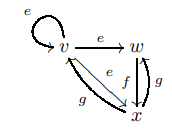Ultragraph C*-algebra
In mathematics, an ultragraph C*-algebra is a universal C*-algebra generated by partial isometries on a collection of Hilbert spaces constructed from ultragraphs.[1]pp. 6-7. These C*-algebras were created in order to simultaneously generalize the classes of graph C*-algebras and Exel–Laca algebras, giving a unified framework for studying these objects.[1] This is because every graph can be encoded as an ultragraph, and similarly, every infinite graph giving an Exel-Laca algebras can also be encoded as an ultragraph.
Definitions
Ultragraphs
An ultragraph [math]\displaystyle{ \mathcal{G} = (G^0, \mathcal{G}^1, r, s) }[/math] consists of a set of vertices [math]\displaystyle{ G^0 }[/math], a set of edges [math]\displaystyle{ \mathcal{G}^1 }[/math], a source map [math]\displaystyle{ s:\mathcal{G}^1 \to G^0 }[/math], and a range map [math]\displaystyle{ r : \mathcal{G}^1 \to P(G^0) \setminus \{ \emptyset \} }[/math] taking values in the power set collection [math]\displaystyle{ P(G^0) \setminus \{ \emptyset \} }[/math] of nonempty subsets of the vertex set. A directed graph is the special case of an ultragraph in which the range of each edge is a singleton, and ultragraphs may be thought of as generalized directed graph in which each edges starts at a single vertex and points to a nonempty subset of vertices.
Example
An easy way to visualize an ultragraph is to consider a directed graph with a set of labelled vertices, where each label corresponds to a subset in the image of an element of the range map. For example, given an ultragraph with vertices and edge labels
[math]\displaystyle{ \mathcal{G}^0 = \{v,w,x \} }[/math], [math]\displaystyle{ \mathcal{G}^1 = \{e,f,g \} }[/math]
with source an range maps
[math]\displaystyle{ \begin{matrix} s(e) = v & s(f) = w & s(g) = x \\ r(e) = \{v,w,x \} & r(f) = \{x \} & r(g) = \{v,w \} \end{matrix} }[/math]
can be visualized as the image on the right.
Ultragraph algebras
Given an ultragraph [math]\displaystyle{ \mathcal{G} = (G^0, \mathcal{G}^1, r, s) }[/math], we define [math]\displaystyle{ \mathcal{G}^0 }[/math] to be the smallest subset of [math]\displaystyle{ P(G^0) }[/math] containing the singleton sets [math]\displaystyle{ \{ \{ v \} : v \in G^0 \} }[/math], containing the range sets [math]\displaystyle{ \{ r(e) : e \in \mathcal{G}^1 \} }[/math], and closed under intersections, unions, and relative complements. A Cuntz–Krieger [math]\displaystyle{ \mathcal{G} }[/math]-family is a collection of projections [math]\displaystyle{ \{ p_A : A \in \mathcal{G}^0 \} }[/math] together with a collection of partial isometries [math]\displaystyle{ \{ s_e : e \in \mathcal{G}^1 \} }[/math] with mutually orthogonal ranges satisfying
- [math]\displaystyle{ p_{\emptyset} }[/math], [math]\displaystyle{ p_A p_B = p_{A \cap B} }[/math], [math]\displaystyle{ p_A + p_B - p_{A \cap B} = p_{A \cup B} }[/math] for all [math]\displaystyle{ A \in \mathcal{G}^0 }[/math],
- [math]\displaystyle{ s_e^*s_e = p_{r(e)} }[/math] for all [math]\displaystyle{ e \in \mathcal{G}^1 }[/math],
- [math]\displaystyle{ p_v = \sum_{s(e)=v} s_e s_e^* }[/math] whenever [math]\displaystyle{ v \in G^0 }[/math] is a vertex that emits a finite number of edges, and
- [math]\displaystyle{ s_e s_e^* \le p_{s(e)} }[/math] for all [math]\displaystyle{ e \in \mathcal{G}^1 }[/math].
The ultragraph C*-algebra [math]\displaystyle{ C^*(\mathcal{G}) }[/math] is the universal C*-algebra generated by a Cuntz–Krieger [math]\displaystyle{ \mathcal{G} }[/math]-family.
Properties
Every graph C*-algebra is seen to be an ultragraph algebra by simply considering the graph as a special case of an ultragraph, and realizing that [math]\displaystyle{ \mathcal{G}^0 }[/math] is the collection of all finite subsets of [math]\displaystyle{ G^0 }[/math] and [math]\displaystyle{ p_A = \sum_{v \in A} p_v }[/math] for each [math]\displaystyle{ A \in \mathcal{G}^0 }[/math]. Every Exel–Laca algebras is also an ultragraph C*-algebra: If [math]\displaystyle{ A }[/math] is an infinite square matrix with index set [math]\displaystyle{ I }[/math] and entries in [math]\displaystyle{ \{ 0, 1 \} }[/math], one can define an ultragraph by [math]\displaystyle{ G^0 := }[/math], [math]\displaystyle{ G^1 := I }[/math], [math]\displaystyle{ s(i) = i }[/math], and [math]\displaystyle{ r(i) = \{ j \in I : A(i,j)=1 \} }[/math]. It can be shown that [math]\displaystyle{ C^*(\mathcal{G}) }[/math] is isomorphic to the Exel–Laca algebra [math]\displaystyle{ \mathcal{O}_A }[/math].[1]
Ultragraph C*-algebras are useful tools for studying both graph C*-algebras and Exel–Laca algebras. Among other benefits, modeling an Exel–Laca algebra as ultragraph C*-algebra allows one to use the ultragraph as a tool to study the associated C*-algebras, thereby providing the option to use graph-theoretic techniques, rather than matrix techniques, when studying the Exel–Laca algebra. Ultragraph C*-algebras have been used to show that every simple AF-algebra is isomorphic to either a graph C*-algebra or an Exel–Laca algebra.[2] They have also been used to prove that every AF-algebra with no (nonzero) finite-dimensional quotient is isomorphic to an Exel–Laca algebra.[2]
While the classes of graph C*-algebras, Exel–Laca algebras, and ultragraph C*-algebras each contain C*-algebras not isomorphic to any C*-algebra in the other two classes, the three classes have been shown to coincide up to Morita equivalence.[3]
See also
- Leavitt path algebra
- Exel–Laca algebras
- Infinite matrix
- Infinite graph
Notes
- ↑ 1.0 1.1 1.2 A unified approach to Exel–Laca algebras and C*-algebras associated to graphs, Mark Tomforde, J. Operator Theory 50 (2003), no. 2, 345–368.
- ↑ 2.0 2.1 Realization of AF-algebras as graph algebras, Exel–Laca algebras, and ultragraph algebras, Takeshi Katsura, Aidan Sims, and Mark Tomforde, J. Funct. Anal. 257 (2009), no. 5, 1589–1620.
- ↑ Graph algebras, Exel–Laca algebras, and ultragraph algebras coincide up to Morita equivalence, Takeshi Katsura, Paul Muhly, Aidan Sims, and Mark Tomforde, J. Reine Angew. Math. 640 (2010), 135–165.
 |


